Designing your garden can be a tricky task. Trying to achieve landscape balance, finding flowers that partner well, and where to put them. Plus, most of us gardeners want to enjoy beautiful colors all season long. To make things easier for you we have found some of the prettiest flowers out there.
Many flowers bloom for only a few weeks, some only a day. We have selected the longest-blooming flowers that flower over at least two seasons. Some all year long in the right conditions. By selecting a range of flowers that bloom in different periods you’ll achieve lots of color throughout the year.
And because not every garden, or gardener, is the same, we have selected a mixture of flowers. All cover a range of colors, plant types, needs, and zone preferences. With cottage classics like Snapdragons, and some less well-known flowers such as the Hot Water Plant. So, let’s see which flowers tick your all-season-long list.
Astilbes
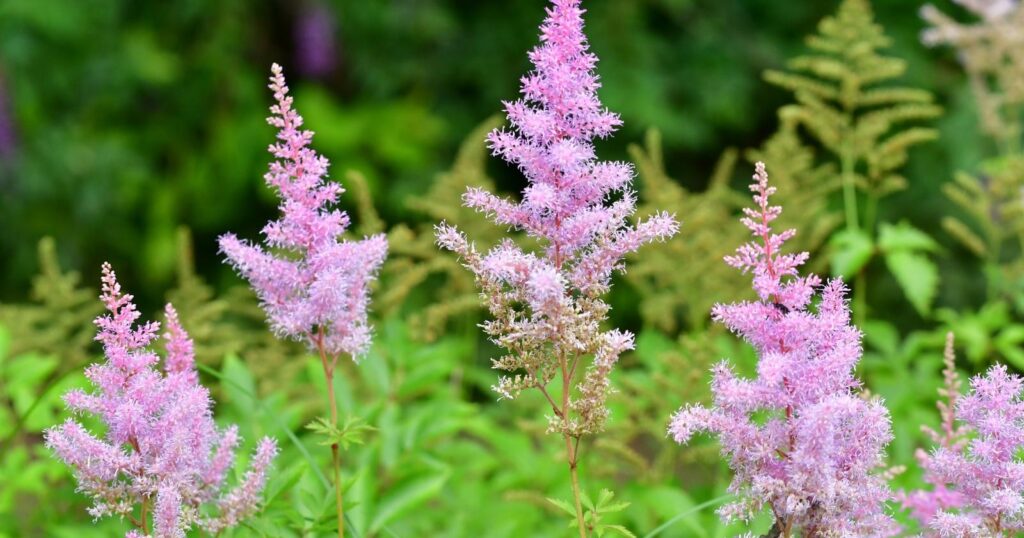
Scientific Name: Astilbes
- Bloom Time: Spring – Summer
- Plant Type: Perennial
- Sun Exposure: Partial sun, shade
- Soil pH: Acid, Alkaline, Neutral
- Plant Zone: 3 – 9
We kick the list off with impressively colorful and low-maintenance Astilbes. There are 25 species of Astilbes, falling into early, mid, or late blooming seasons. So be sure to select an Astilbe from each group for extended bloom time. Astilbe japonica and Astilbe chinensis are great options for color all season long.
Astilbes sport a range of colors including white, pink, purple, and red. Their feathery plumes can reach heights of up to 4 feet, whereas some only grow up to 12 inches tall. They need moist but well-drained soils to thrive.
Baby’s Breath
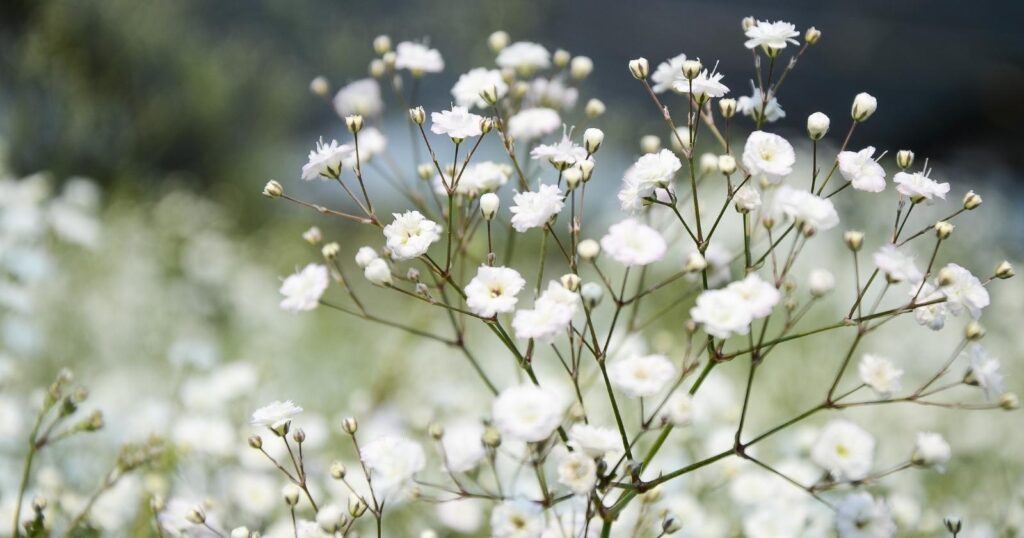
Scientific Name: Gypsophila paniculata
- Bloom Time: Summer – Fall
- Plant Type: Perennial
- Sun Exposure: Full sun
- Soil pH: Alkaline, Neutral
- Plant Zone: 3 – 9
Baby’s Breath is ideal for adding fluffy texture and delicate white to any landscape. It is great for softening surrounding plants and making brighter-colored flowers pop too. It grows up to 3 feet tall once mature.
Baby’s Breath blooms from early summer through to fall. It prefers full sun, but has low water needs and can thrive in dry to average soils. It is a low-maintenance choice that returns year after year. Making it a popular choice for many gardeners. It likes to be left alone once established, so be sure to plant it in the right place.
Beardtongue
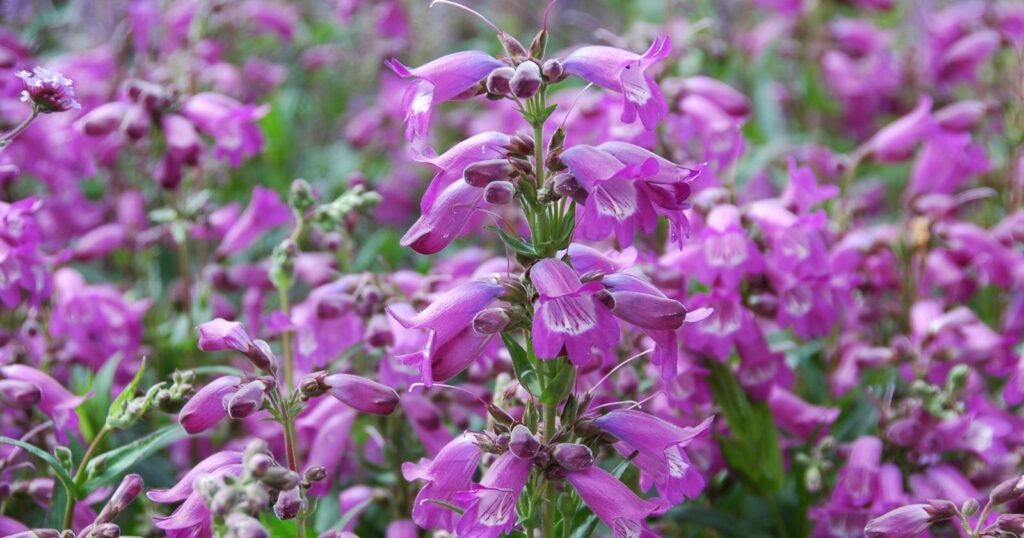
Scientific Name: Penstemon
- Bloom Time: Late Spring – Fall
- Plant Type: Perennial
- Sun Exposure: Full sun, partial sun
- Soil pH: Acid, Alkaline, Neutral
- Plant Zone: 7 – 10
There are approximately 250 species of Penstemon, and most thrive in warmer climates. Two varieties that are noted for their long blooming time are ‘Apple Blossom’ and ‘Stapleford Gem’. From late spring through to fall, these Beardtongues provide warm lilac, pink, and peachy hues to your perennial beds.
Beardtongues produce beautiful trumpet-shaped flowers, usually with a contrasting colored throat. They grow up to 2 feet tall. They have low water needs and can survive in dry soils. Your soil must be well-drained to host these plants, but, overall, it is an easygoing pick for your garden.
Bellflower
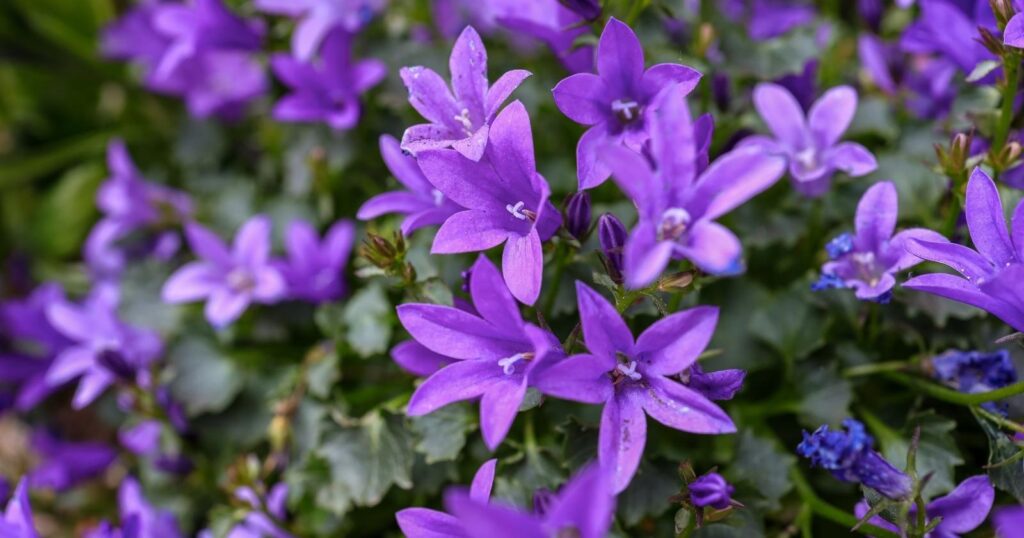
Scientific Name: Campanula
- Bloom Time: Late Spring – Fall
- Plant Type: Perennial
- Sun Exposure: Full sun, partial sun
- Soil pH: Alkaline, Neutral
- Plant Zone: 4 – 9
In Latin, ‘campanula’ means ‘little bell’. And when you see the delightful flowers it’s easy to see why it has earned this name. Most Bellflowers bloom from spring and all summer long. The hybrid ‘Summertime Blues’ is one of the longest-blooming Bellflowers, which extends its bloom time into fall.
Campanulas sport purple, pink, lilac, and white colors. Most Campanulas reach up to 2 to 3 feet tall once they mature. They are another easy-going option that needs average moisture and well-drained soils. Plant Bellflowers in groups for the best perennial show.
Bergenia
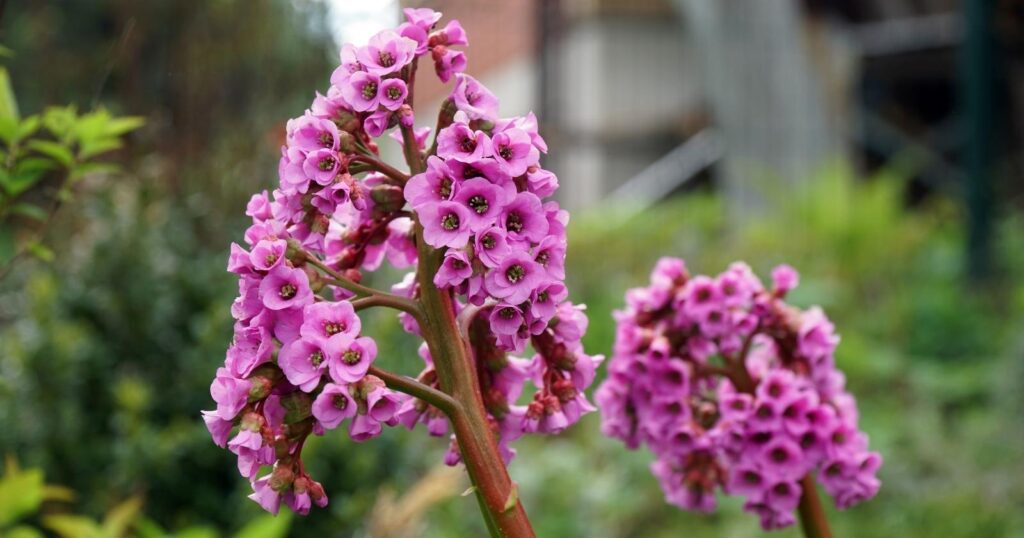
Scientific Name: Bergenia crassifolia
- Bloom Time: Winter – Spring
- Plant Type: Perennial
- Sun Exposure: Full sun, partial sun, shade
- Soil pH: Acid, Alkaline, Neutral
- Plant Zone: 3 – 8
Sometimes known as Korean Elephant’s Ears, this showy perennial blooms from winter into spring. Providing your garden with a pop of purple-pink-colored clusters when most other flowers are no longer around. It is evergreen too, with wonderful rosettes of toothed deep-green leaves, tinged with red in the winter.
Growing up to 2 feet tall in a clump-forming habit, this Bergenia makes great ground cover or a specimen plant. It tolerates a wide range of conditions, except for hot, dry climates. And it thrives in moist, well-drained soils. So, if you’re seeking an easy-going, long-blooming plant with all-year interest, this is a top pick.
Black-Eyed Susan
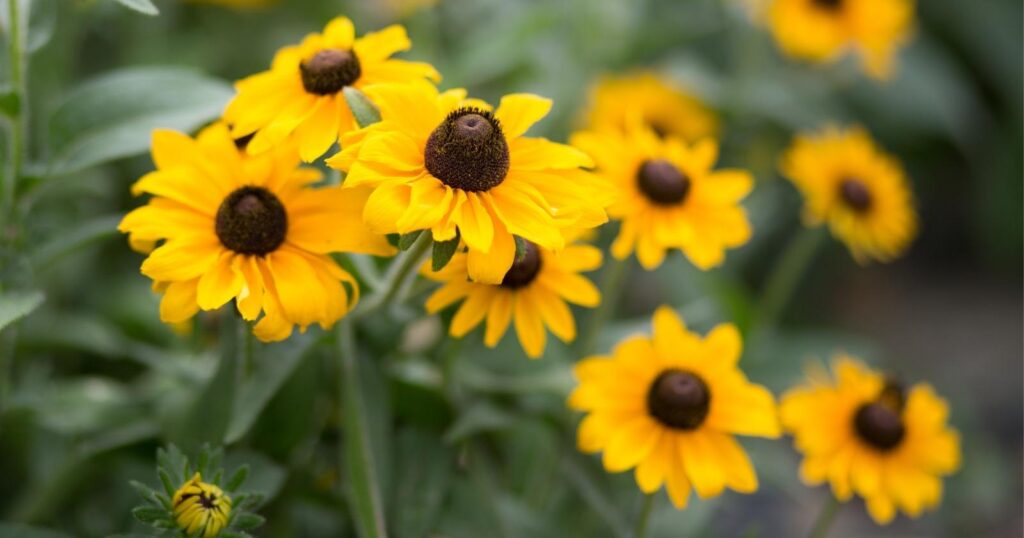
Scientific Name: Rudbeckia hirta
- Bloom Time: Summer – Fall
- Plant Type: Annuals, Perennials
- Sun Exposure: Full sun
- Soil pH: Acid, Alkaline, Neutral
- Plant Zone: 3 – 10
Black-Eyed Susans produce a mass of bright yellow flowers with a chocolate dome center. Each flower is carried by a stiff stem, and it attracts a wide array of pollinating insects and birds. Although it is a biennial or short-lived perennial, it seeds freely allowing it to maintain its spot in your garden.
Black-Eyed Susans reach heights of 3 feet and pump one last bit of summer color into your fall garden. It is low maintenance and can tolerate most conditions except wet ones. Keep the well-drained soil dry to moist, and in full sun for the best blooms.
Cape Marigold
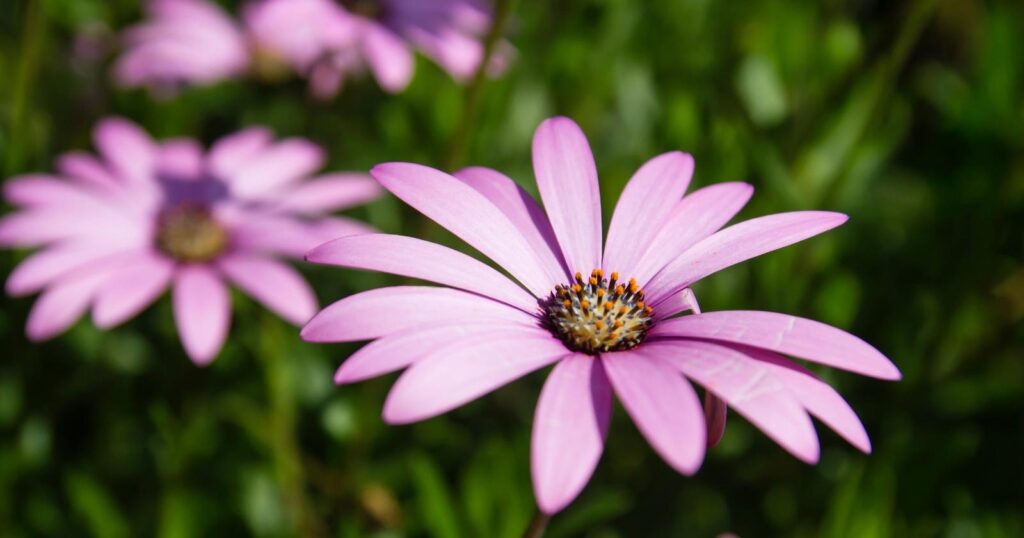
Scientific Name: Dimorphotheca sinuata
- Bloom Time: Spring – Winter
- Plant Type: Annual
- Sun Exposure: Full sun
- Soil pH: Acid, Alkaline, Neutral
- Plant Zone: 2 – 11
Here we have another daisy-like flower. It is a sprawling, upright annual that produces masses of warm, orange-to-yellow blooms. With contrasting dark centers and reddish stems, it’ll make you feel summery even in the colder months. Depending on your location, they can bloom all year round.
As you might expect from a South African native plant, it does not need a lot of water and can tolerate drought. It thrives in sandy, well-drained soils and requires full sun. Bees and butterflies love Cape Marigold. It is low-growing and reaches 12 inches tall.
Catmint
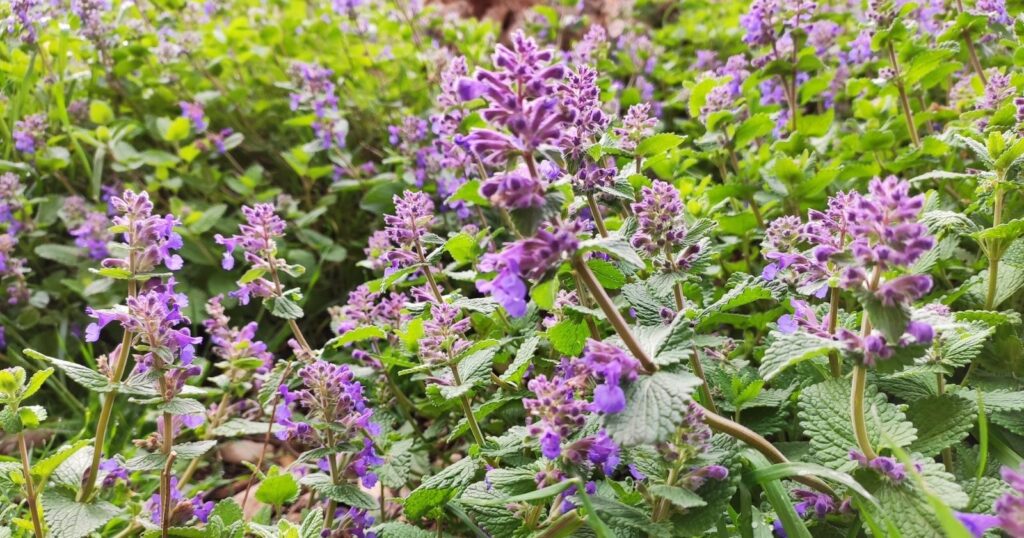
Scientific Name: Nepeta racemosa
- Bloom Time: Spring – Fall
- Plant Type: Perennial
- Sun Exposure: Full sun, partial sun
- Soil pH: Acid, Alkaline, Neutral
- Plant Zone: 4 – 8
This perennial is prized for its extremely long-lasting blooms from spring to fall. It is versatile, resilient, and low maintenance. It can reach 2 feet tall but can be used anywhere in the garden. The clumps of slender stems carry small but showy purple, blue, or white flowers. The gray-green foliage is highly aromatic too, so be sure to plant it within reach.
Catmint can tolerate many conditions, even dry soils as it does not need much water. If you are seeking a long-blooming ground cover, select cultivars such as ‘Little Titch’ or ‘Snowflake’ that reach 12 inches tall.
Coneflower
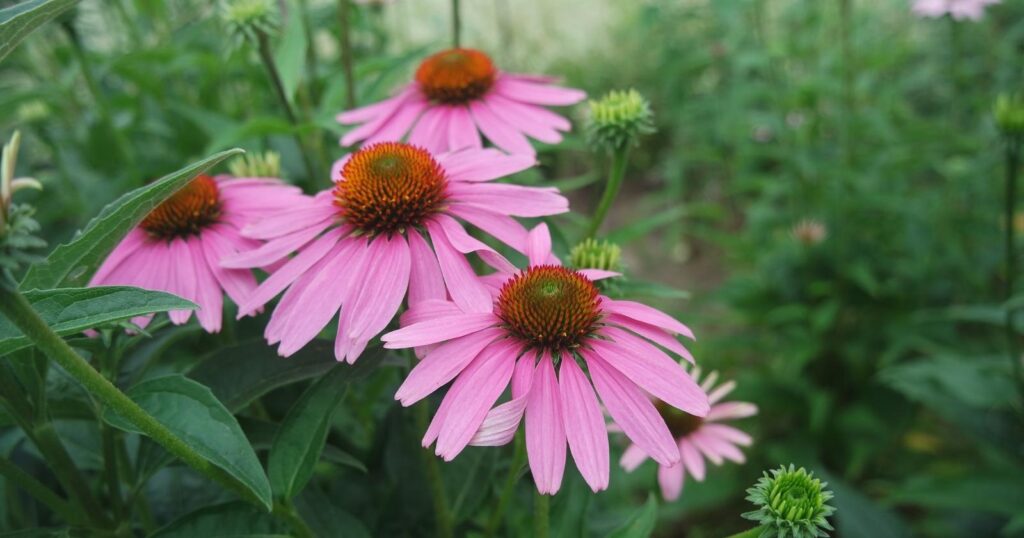
Scientific Name: Echinacea
- Bloom Time: Spring – Fall
- Plant Type: Perennial
- Sun Exposure: Full sun
- Soil pH: Acid, Alkaline, Neutral
- Plant Zone: 3 – 10
No flower is more American than the Coneflower. It is hardy and tolerates neglect well, which is perfect for the forgetful gardener. It has a long blooming season and provides the warmest of colors, including red, orange, yellow, purple, pink, red, and white. The petals usually droop downwards exposing the coned centers. A super pretty addition to any landscape.
Coneflowers grow in clumps up to 48 inches tall. They have low to average water needs and need well-drained dry to medium soils. Butterflies flock in the summer, and birds cherish the dried cones in the winter. Overall, the Coneflower is a must-have for anyone seeking long-lasting color.
Cranesbill
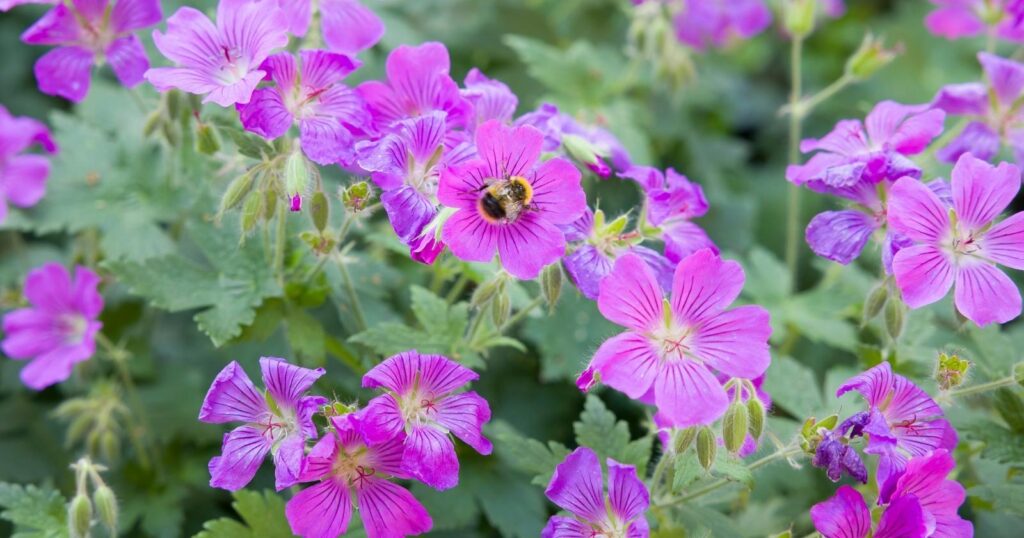
Scientific Name: Geranium
- Bloom Time: Spring – Fall
- Plant Type: Annuals, Perennials
- Sun Exposure: Full sun, partial sun
- Soil pH: Acid, Alkaline, Neutral
- Plant Zone: 5 – 9
Geraniums are a family of around 420 species of annuals, biennials, and perennials. They are adored by gardeners because they are easy to grow and care for, resilient, and wonderfully colorful. Cranesbill cultivars noted for their longer-lasting bloom time compared to others are ‘Rozanne’ and ‘Brookside’ to name just two.
Cranesbills are usually purple, lilac, pink, and white and add a splash of softness to all beds and borders. Some blooms are delicately veined or have contrasting centers for an extra splash of color. They can reach up to 2 feet tall, and have average water needs. They are rabbit and deer-resistant and attract pollinators.
Dahlia
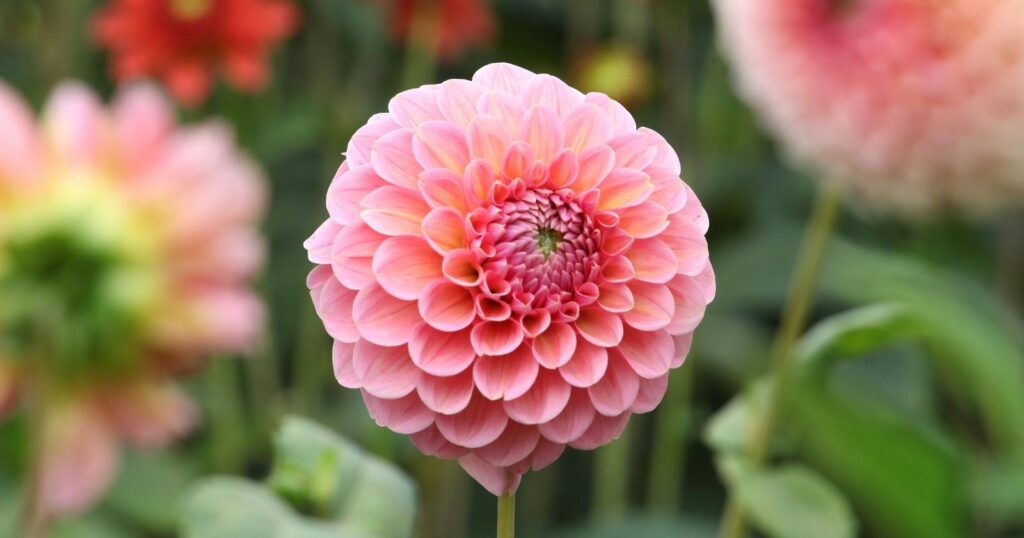
Scientific Name: Dahlia
- Bloom Time: Summer – Fall
- Plant Type: Perennial
- Sun Exposure: Full sun
- Soil pH: Acid, Alkaline, Neutral
- Plant Zone: 8 – 11
There are thousands of varieties of Dahlia, so be sure to do your research and pick the best one for your garden. Generally speaking, Dahlias provide a dramatic burst of bright color all season long. There are lots of different shapes, sizes, and colors to choose from. They range from 12 inches to 6 feet tall, and they prefer sandy, well-drained soils in sunny spots.
Dahlias are a top choice for cut flowers thanks to their bright colors and wide-ranging shapes. They are relatively easy to care for, but as tender bulbs, they may have to be stored inside over winter in colder climates.
Flowering Maple
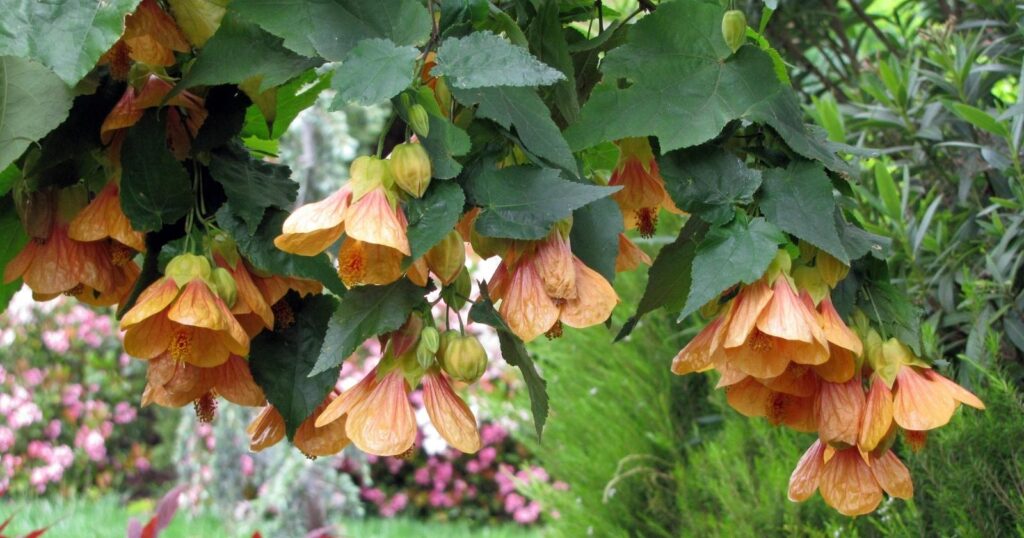
Scientific Name: Abutilon
- Bloom Time: Spring – Fall
- Plant Type: Shrub
- Sun Exposure: Full sun, partial sun
- Soil pH: Acid, Neutral
- Plant Zone: 8 – 11
Flowering Maple is a large shrub that forms in an upright habit It produces pendulous light pink bell-shaped flowers that look a lot like Chinese lanterns. They bloom from spring to fall, sometimes all year long in frost-free areas. These beautiful blooms attract hummingbirds and butterflies making them ideal for wildlife-focused gardens.
The foliage is just as striking as the flowers, which are maple-like, variegated, and showy. Abutilon can grow up to 10 feet tall and 6 feet wide, so be sure to plant it where it has plenty of space. It is an easy-going shrub but it needs moist and rich well-drained soil.
Hot Water Plant
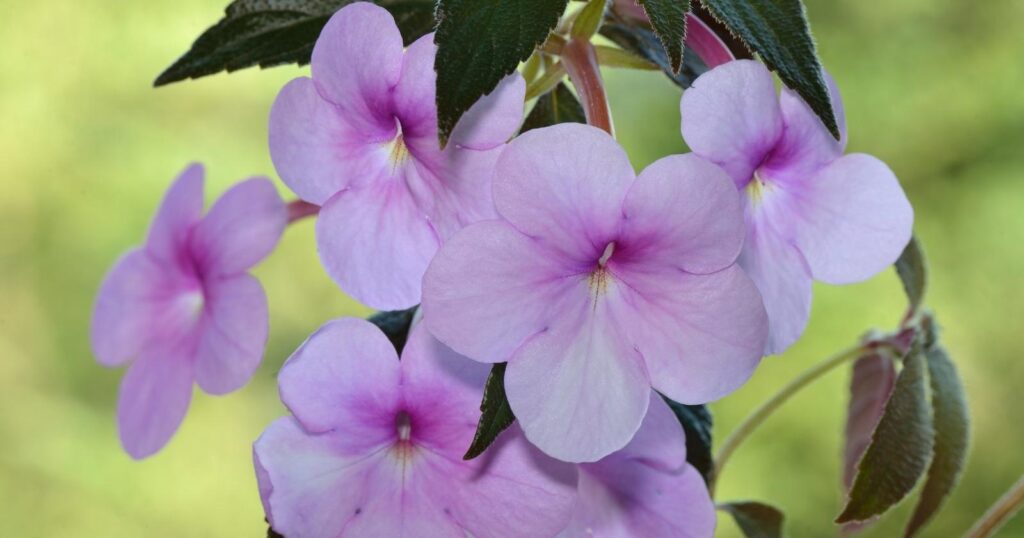
Scientific Name: Achimenes
- Bloom Time: Spring – Fall
- Plant Type: Annual, Perennial
- Sun Exposure: Partial sun
- Soil pH: Acid, Alkaline, Neutral
- Plant Zone: 10 – 11
The Hot Water Plant is also known as the Orchid Pansy, and it is related to the ever-popular African Violet. They bloom from late spring to fall and produce spectacular trumpet-shaped blooms up to 3 inches wide. Their throats are yellow and often speckled. They sport a wide range of colors including purple, pink, scarlet, blue, white, and yellow.
Achimenes are a prized pick for hanging baskets showing off their cascading abilities. They reach up to 24 inches tall and need humus-rich potting soil that is moist, but well-drained. Considered a perennial in zones 10 – 11, but an annual or houseplant in cooler climates.
Hydrangea
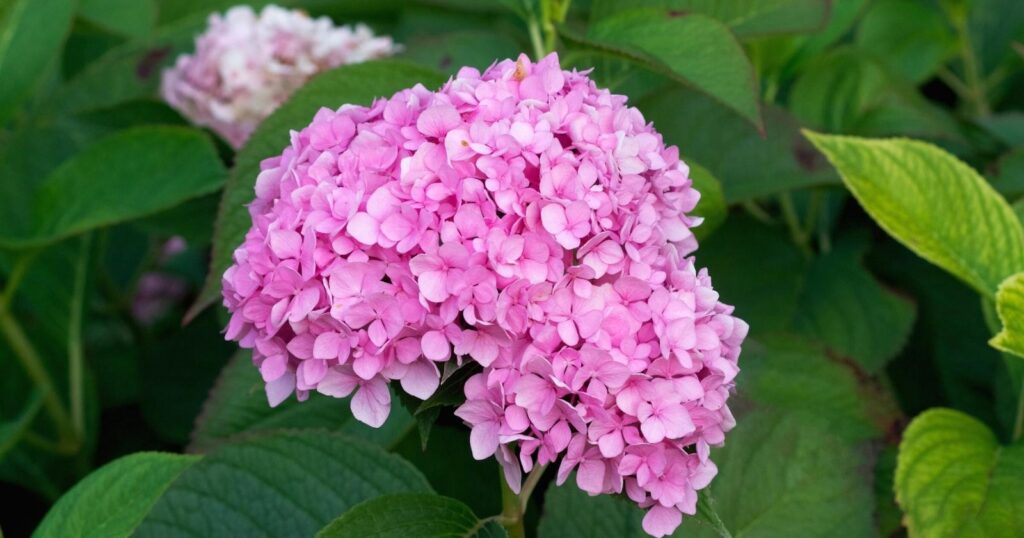
Scientific Name: Hydrangea macrophylla
- Bloom Time: Late spring – Fall
- Plant Type: Perennial shrub
- Sun Exposure: Partial sun
- Soil pH: Acid, Alkaline, Neutral
- Plant Zone: 5 – 9
Hydrangeas are a staple in most landscapes. They provide an array of profuse pink, blue, purple, red, and white blossoms that appear all season long. You can change the color of your versatile Hydrangeas too! Add aluminum sulfate to the soil to make them bluer, or lime to make them pinker.
Cultivars such as ‘Blushing Bride’, ‘Dear Dolores’, or ‘Eternity’ have the longest blooming periods from spring through to fall. Generally, Hydrangeas are low maintenance and require partial sun and moist but well-drained soil. They look great when planted en masse or in containers as a statement piece. They grow to be approximately 4 feet tall.
Ice Plant
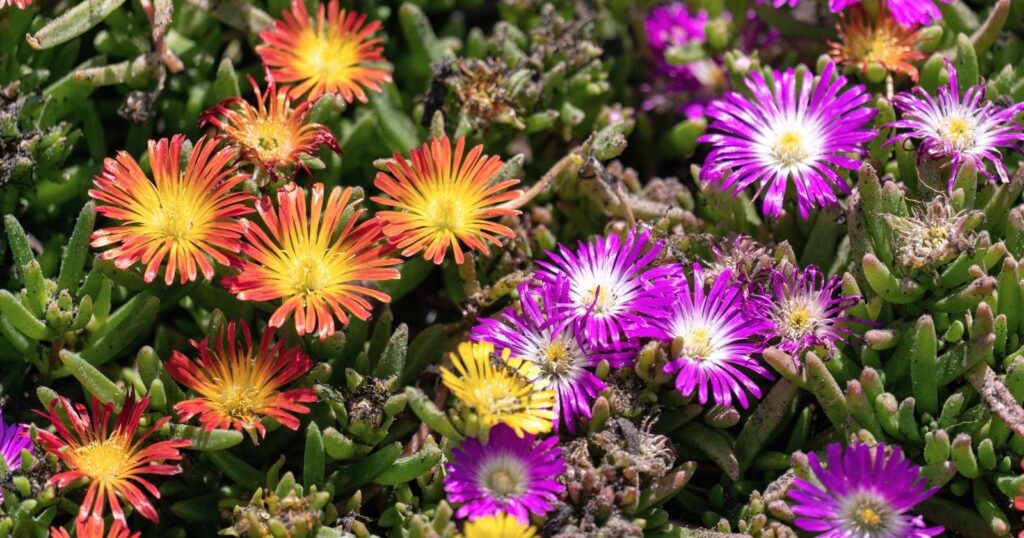
Scientific Name: Delosperma cooperi
- Bloom Time: Summer – Fall
- Plant Type: Succulent
- Sun Exposure: Full sun
- Soil pH: Acid, Alkaline, Neutral
- Plant Zone: 6 – 10
If you have a dry and hot garden and struggling to maintain season-long color, look no further than the Ice Plant. It is an evergreen mat-forming succulent. It blooms at the start of summer through to fall. The blooms are deep pink-purple and cover the entire plant. The spiky petals and intense color make this a wow plant for sure.
It grows up to 6 inches tall but it spreads quick and wide. Like most succulents, it needs dry, well-drained soil with access to full sun. It is great for rock gardens, slopes, and the front of borders.
Ivy Geranium
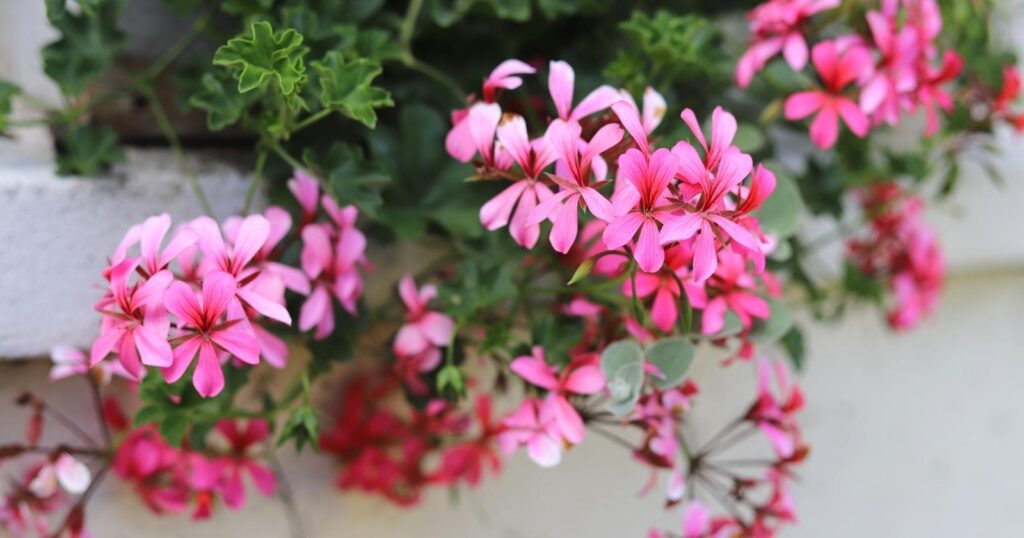
Scientific Name: Pelargonium peltatum
- Bloom Time: Spring – Fall
- Plant Type: Annual, Perennial
- Sun Exposure: Full sun, partial sun
- Soil pH: Alkaline, Neutral
- Plant Zone: 10 – 12
Ivy Geranium produces round clusters of pink, red, white, or lavender clusters of single or double blooms. Its foliage is also appreciated, which is glossy and bright, looking a lot like Ivy. It is easy to care for and needs low to medium moisture. It is toxic to dogs and cats, so keep it out of reach of curious creatures.
Pelargonium is native to South Africa, so it needs hot and dry conditions to thrive. In the right conditions, it will return year after year. But in cooler climates, it is considered an annual. It blooms early until the first frosts. This flower is a top choice for hanging baskets or window boxes where you can appreciate its falling habit reaching 2 feet long.
Lavender
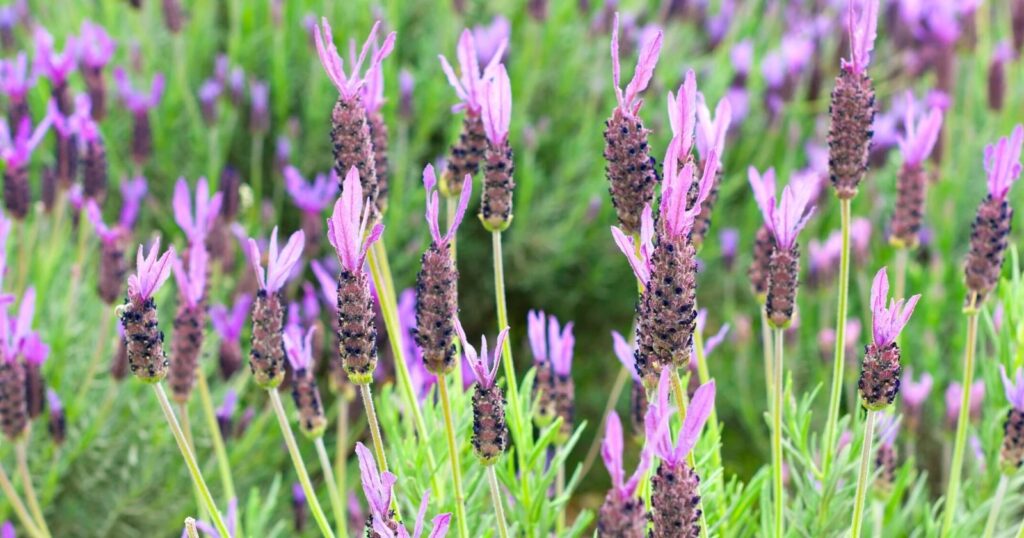
Scientific Name: Lavandula stoechas
- Bloom Time: Spring – Fall
- Plant Type: Perennial Shrub
- Sun Exposure: Full sun
- Soil pH: Acid, Alkaline, Neutral
- Plant Zone: 6 – 10
Sometimes known as Bract Lavender, this is a hardy and long-lasting bloomer with deep violet blooms. It first blooms in spring, then again in summer, and sometimes in fall. It is evergreen in warmer climates. The foliage is gray-green and highly fragrant. It needs full sun, and dry to medium, well-drained soil to thrive. It can tolerate poor soil and drought.
Lavender never fails to attract masses of bees and butterflies, making it a must for the wildlife garden. It can grow up to 2 feet tall and wide, and it looks great as a hedge, border, or in a container. Lavender has so many uses besides being ornamental, so be sure to make space in your landscape for this perennial.
Mexican Daisy
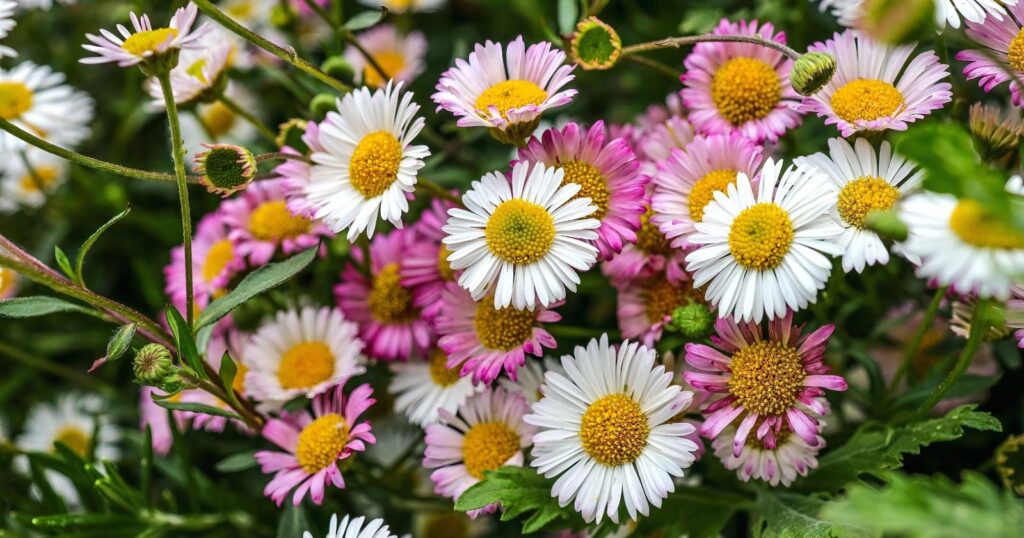
Scientific Name: Erigeron karvinskianus
- Bloom Time: Spring – Fall
- Plant Type: Perennial
- Sun Exposure: Full sun
- Soil pH: Acid, Alkaline, Neutral
- Plant Zone: 6 – 9
The Mexican Daisy is noted for its sometimes year-round production of mass blooms. The small flowers open white, and gradually fade to soft pink and purple over time. With its changing color and hairy foliage, it is an attractive addition to all landscapes. It makes a wonderful ground cover and works well smoothed over rocks or paving.
Mexican Daisy is an easygoing plant that acts as a magnet for bees and butterflies. It can grow up to 2 feet tall and it is a prolific self-seeder in the right conditions. Mexican Daisies need fertile and well-drained soils to thrive. It prefers to be dry, but make sure it does not dry out in the summer.
Perennial Sweet Pea
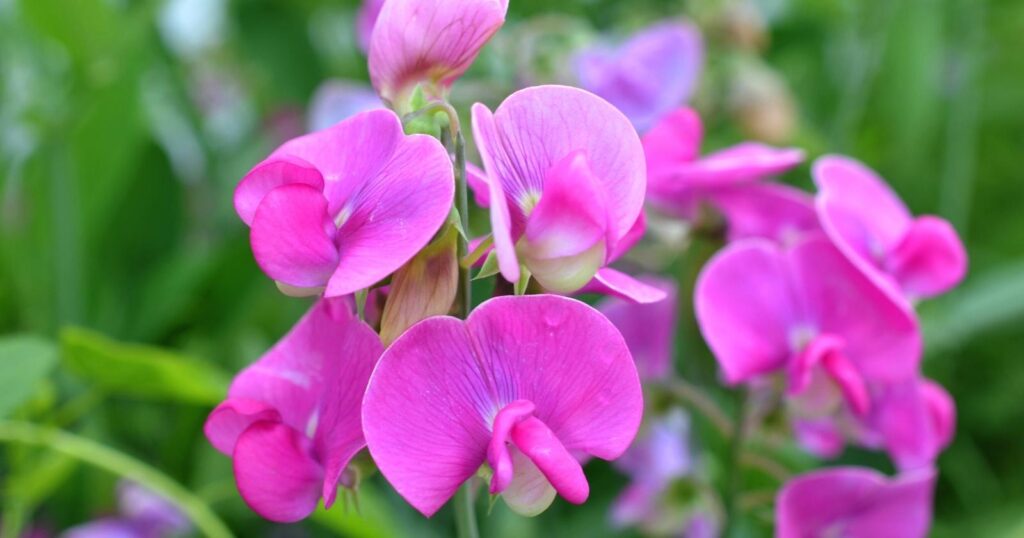
Scientific Name: Lathyrus latifolius
- Bloom Time: Summer – Fall
- Plant Type: Perennial climber
- Sun Exposure: Full sun, partial sun
- Soil pH: Acid, Alkaline, Neutral
- Plant Zone: 5 – 9
The Everlasting Pea is a quick climber that produces racemes of 5 to 11 pastel-colored rose, purple, and white flowers. It is a long bloomer from summer through to fall. Perennial Sweet Pea clings to anything for support, so place it somewhere it can support itself upwards. It grows up to 9 feet tall and 6 feet wide.
Sweet Peas are low maintenance and are not too picky about their conditions, but prefer cool and well-drained soils. This Sweet Pea self-seeds easily so be sure to keep it in check if you do not want it to spread. It is native to the Mediterranean but has grown so much in America that it is now considered to be invasive in some parts.
Petunia
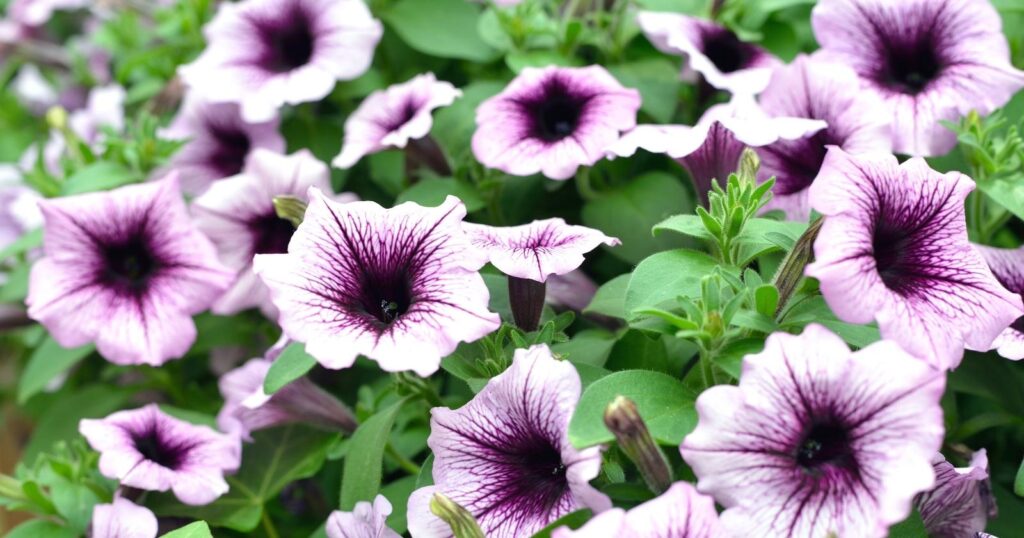
Scientific Name: Petunia
- Bloom Time: Spring – Fall
- Plant Type: Annual, Perennial
- Sun Exposure: Full sun, partial sun
- Soil pH: Acid, Alkaline, Neutral
- Plant Zone: 2 – 11
Petunias are one of the most popular bedding plant choices for many reasons. They are available in every color imaginable, are easy to grow, and are super showy with their graceful trumpet-shaped blooms. They usually reach heights of 2 feet and make great trailing plants for baskets.
Petunias are tolerant of many conditions except for frost, which is why they are considered to be annuals in most climates. In 10 – 11, they are listed as perennial. They need at least 5 hours of sun a day to thrive. Petunias need hummus-rich and moist, well-drained soil. Butterflies and hummingbirds always appreciate a pack of pretty Petunias to feast on.
Pot Marigold
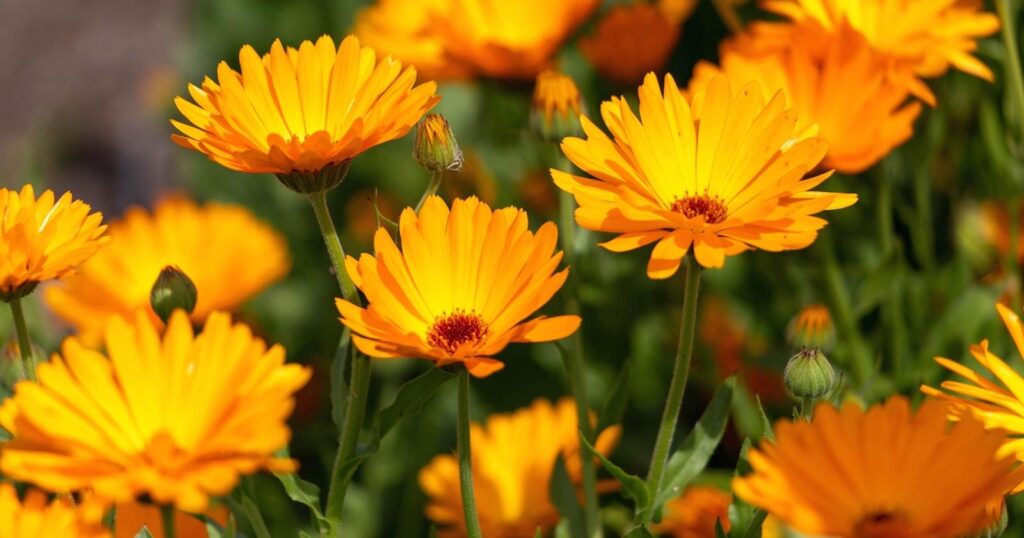
Scientific Name: Calendula officinalis
- Bloom Time: Spring – Fall
- Plant Type: Annual
- Sun Exposure: Full sun, partial sun
- Soil pH: Acid, Alkaline, Neutral
- Plant Zone: 2 – 11
Also known as English Marigold, this Marigold is picked for its warm, bright flowers and continuous blooms all season long. It requires little effort but provides an abundance of warm orange, yellow, and gold hues. The daisy-like flowers match most other plants and can be planted anywhere in the garden. They are also edible and the foliage is fragrant.
Calendula prefers cool weather and is intolerant of intense heat. It grows 2 feet tall and spreads 5 feet wide. It has average water needs and needs well-drained soils to thrive. Butterflies and other insects are attracted to this flower, and few pests or diseases affect it.
Reblooming Daylily
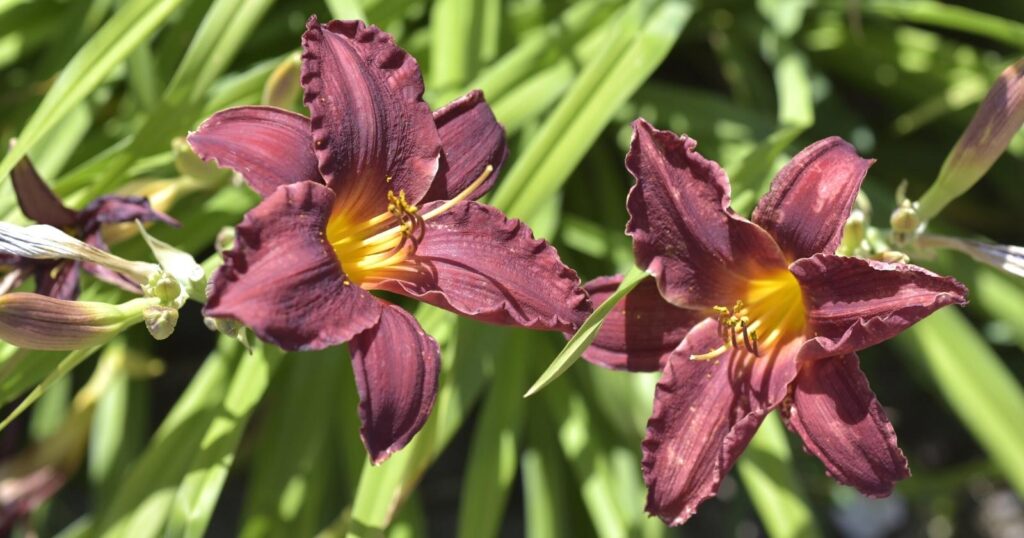
Scientific Name: Hemerocallis
- Bloom Time: Summer – Fall
- Plant Type: Perennial
- Sun Exposure: Full sun, partial sun
- Soil pH: Acid, Alkaline, Neutral
- Plant Zone: 3 – 9
There are many species of Reblooming Daylilies, and they come in a variety of colors. The most common colors are yellow, orange, red, pink, purple, and white. And some boast multiple colors for extra pizzazz. Often named the ‘perfect perennial’, it is easygoing and needs moist, well-drained soil.
Reblooming Daylilies can grow up to 4 feet tall, and some half that size. So be sure to pick the right one for your landscape. The cultivar, ‘Big Time Happy’, has an extended bloom time that starts in late spring. Making this a good choice if you want to squeeze as much color into your beds as possible. It also has a lovely lemon fragrance to enjoy.
Rose of Sharon
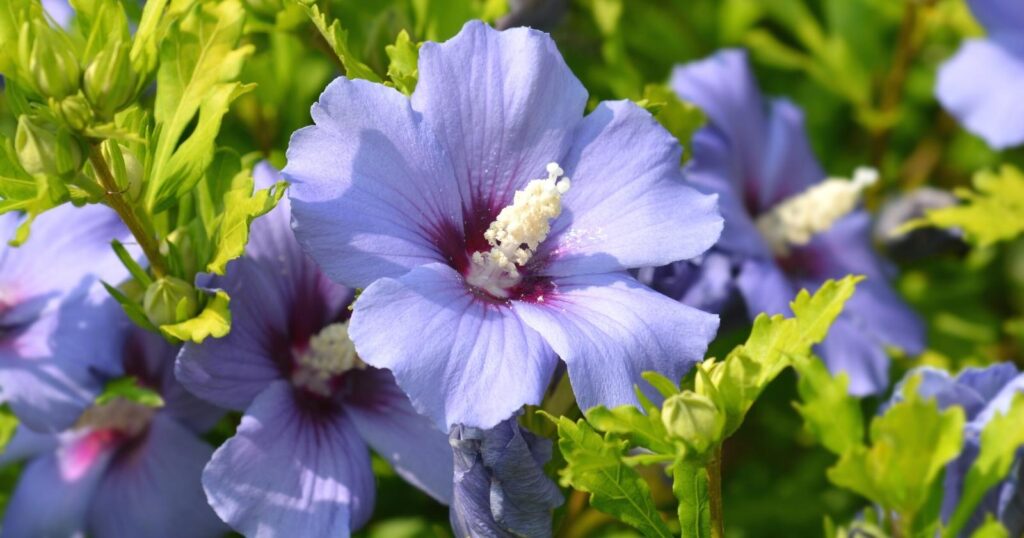
Scientific Name: Hibiscus syriacus
- Bloom Time: Summer – Fall
- Plant Type: Perennial shrub
- Sun Exposure: Full sun, partial sun
- Soil pH: Alkaline, Neutral
- Plant Zone: 5 – 8
The Hibiscus plant never fails to inject an exotic feel into any landscape. It is a vigorous shrub that produces large flowers that bloom continuously from summer to fall. Each has a protruding and contrasting colored stamen. Perennial blooms are red, pink, blue, and white, decorating the shrub. Its foliage is large and changes color throughout the season.
Rose of Sharon can grow up to 12 feet tall and 10 feet wide, so it either needs plenty of space or shaping. Its size makes it ideal for the back of the border or as a screen. It prefers moist and organically rich soils. It is considered invasive in Indiana and surrounding areas.
Sage
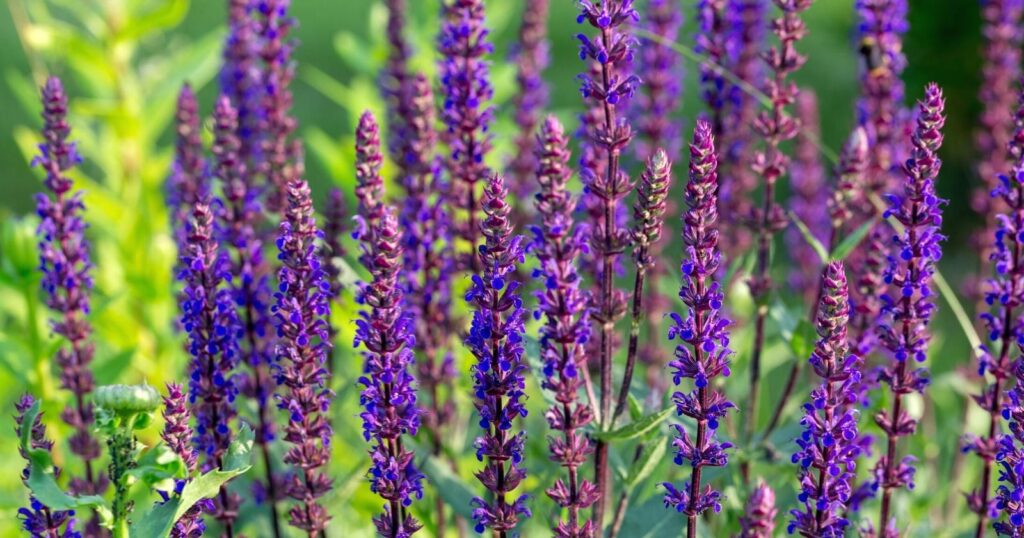
Scientific Name: Salvia nemorosa
- Bloom Time: Spring – Summer
- Plant Type: Perennial
- Sun Exposure: Full sun
- Soil pH: Acid, Alkaline, Neutral
- Plant Zone: 4 – 9
This Woodland Sage is a top pick for many gardeners. It produces dark stems with glowing purple flowers that burst out of beds and other spaces. It appears in spring all the way through to summer adding vertical interest. The cultivar, ‘Caradonna’ is a multiple award-winner.
It is versatile, low maintenance, and resistant to most pests and diseases. Sage needs average, well-drained soils, preferably sandy soils. It is a butterfly and hummingbird magnet. Sage is a compact growing plant that grows up to 24 inches tall and wide.
Scarlet Bee Balm
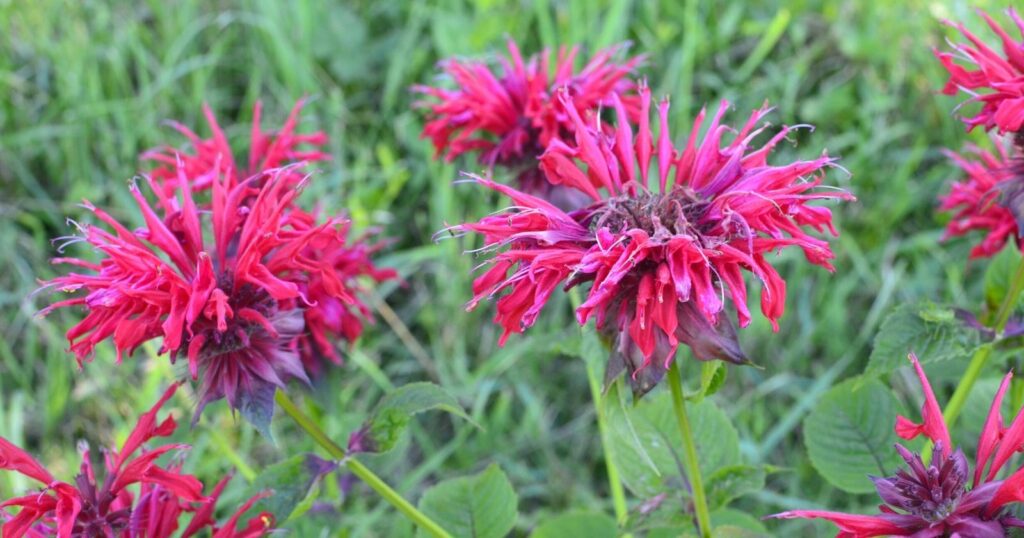
Scientific Name: Monarda didyma
- Bloom Time: Spring – Fall
- Plant Type: Perennial
- Sun Exposure: Full sun, partial sun
- Soil pH: Acid, Alkaline, Neutral
- Plant Zone: 4 – 9
This is an exotic looking perennial that boasts bright scarlet globular-shaped heads which last for months. Each one sits atop tall stems which stand out from the deep-green, long foliage. The foliage has a minty fragrance that is activated with the slightest touch, and they can be eaten too.
Scarlet Bee Balm is native to eastern North America and is found in wet woodlands and beside streams. Its native habitat means that it has average to high water needs, and the soil must never dry out. It reaches 4 feet high, and spreads easily, forming colonies. It attracts pollinating insects and birds.
Shrubby Cinquefoil
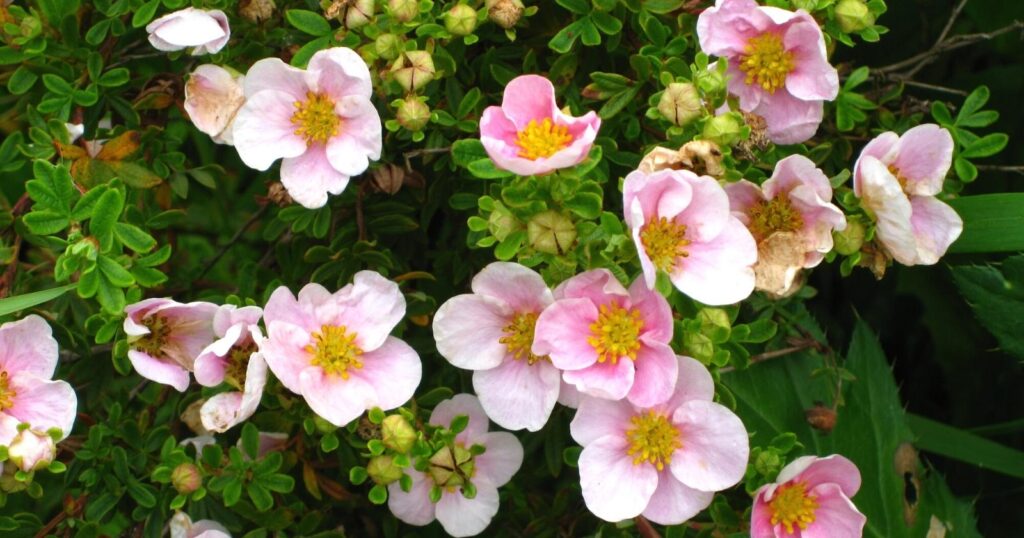
Scientific Name: Potentilla fruticosa
- Bloom Time: Spring – Fall
- Plant Type: Perennial
- Sun Exposure: Full sun, partial sun
- Soil pH: Acid, Alkaline, Neutral
- Plant Zone: 3 – 7
This is a bushy and compact shrub with deep green small foliage. It produces masses of large, bright yellow, strawberry-like flowers that cover the entire plant over an extended blooming period. It is an extremely easy plant to care for, which is why gardeners adore it.
Shrubby Cinquefoil grows up to 4 feet tall and 5 feet wide. It needs evenly moist soil to thrive. Otherwise, it is tough as nails and can withstand most conditions. Drought-hardy in summer, cold resistant in the winter, this is a great choice for gardeners with little time on their hands.
Snapdragon
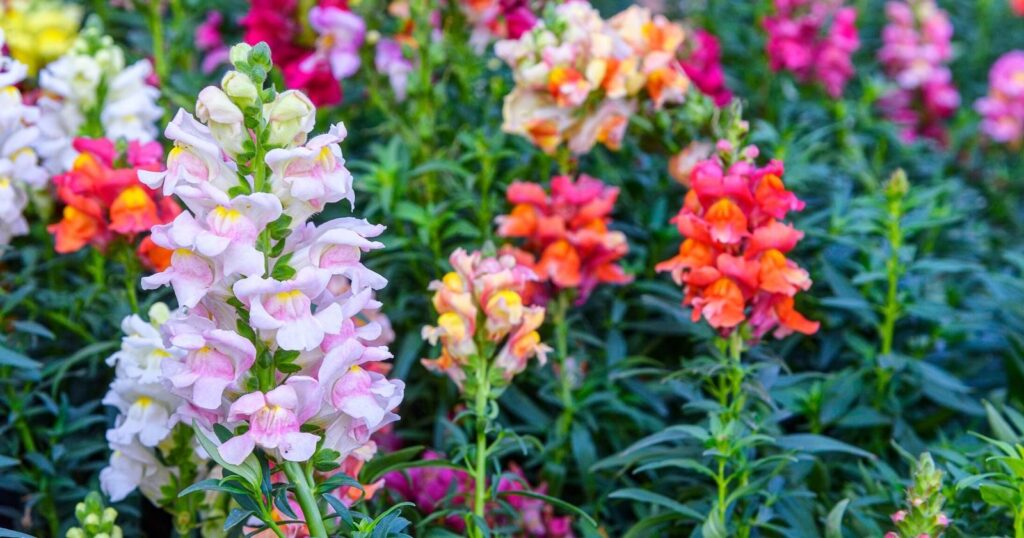
Scientific Name: Antirrhinum majus
- Bloom Time: Spring – Fall
- Plant Type: Annual, Perennial
- Sun Exposure: Full sun
- Soil pH: Acid, Alkaline, Neutral
- Plant Zone: 5 – 10
This cottage garden favorite is a long bloomer providing a selection of bright colors including orange, peach, yellow, white, red, pink, purple, and multi-colors. The tall stems are topped with lots of individual ruffled blooms. They are very easy to grow and low maintenance. Plus, butterflies and hummingbirds love them.
Snapdragons are grown as annuals. However many consider them to be short-lived perennials as they can withstand small bouts of frost. There are 4 groups of Snapdragons classified by height, ranging from 4 inches up to 3 feet tall. Regardless of height, they stand out dramatically against other flowers in the bed.
Sneezeweed
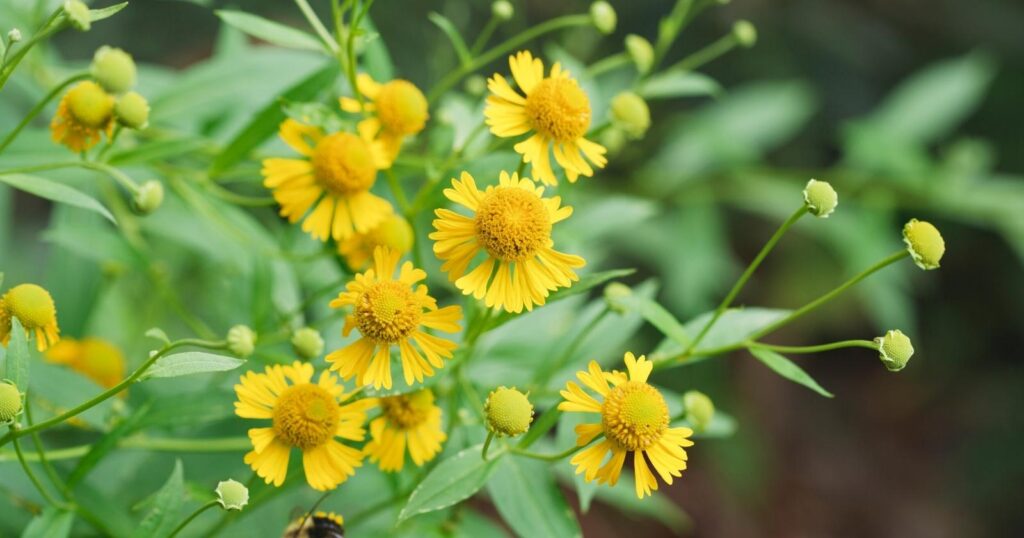
Scientific Name: Helenium amarum
- Bloom Time: Spring – Fall
- Plant Type: Annual
- Sun Exposure: Full sun, partial sun
- Soil pH: Acid, Alkaline, Neutral
- Plant Zone: 3 – 10
There are many varieties of Sneezeweed, but this Yellow Sneezeweed is the longest-blooming of them all. Providing a burst of summer color from spring through to fall, you won’t be disappointed with this choice. The slender stems are topped with 5 – 10 delicate daisy-like flowers, which look great when planted in large groups and drifts.
Sneezeweed is native to America, making it all the more appealing to dedicated gardeners. It is simple to care for and has low to average water needs. It blooms best in full sun and is ideal for hot rock spaces. And the nectar-rich centers attract all pollinators.
Spiked Speedwell
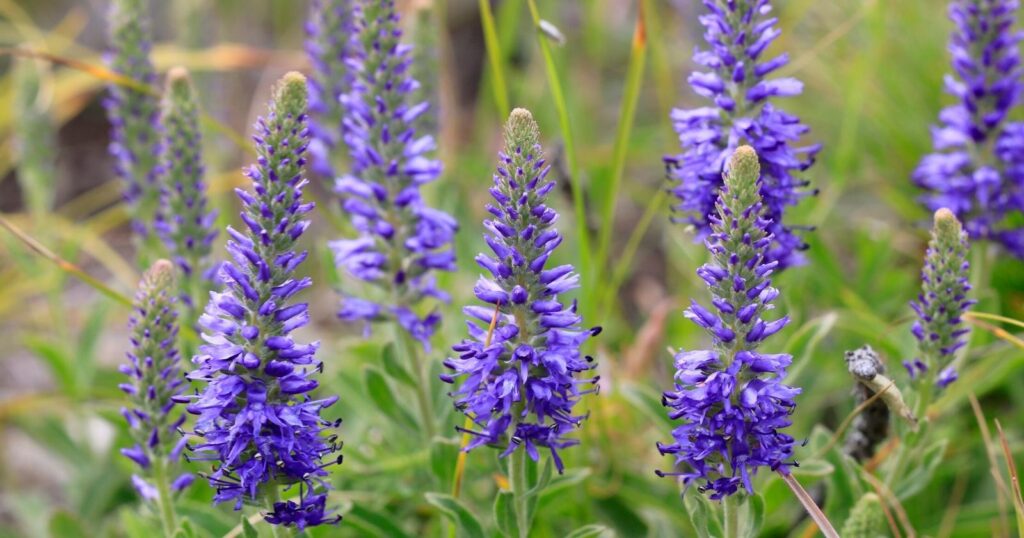
Scientific Name: Veronica
- Bloom Time: Summer – Fall
- Plant Type: Perennial
- Sun Exposure: Full sun, partial sun
- Soil pH: Acid, Alkaline, Neutral
- Plant Zone: 4 – 9
Spiked Speedwell, or simply Speedwell, is a carefree option for the perennial lover. It produces long spikes sprinkled with small pink, purple, blue, or white star-shaped blooms. It adds vertical lines to beds and borders and grows up to 3 feet tall. This perennial looks great in drifts or with traditional roses.
It has average water needs and needs moist, well-drained soils. It is fairly pest-free and butterflies are immensely attracted to it. The cultivar ‘Moody Blues’ is an exceptionally long bloomer, all summer long through to the fall.
Stonecrop
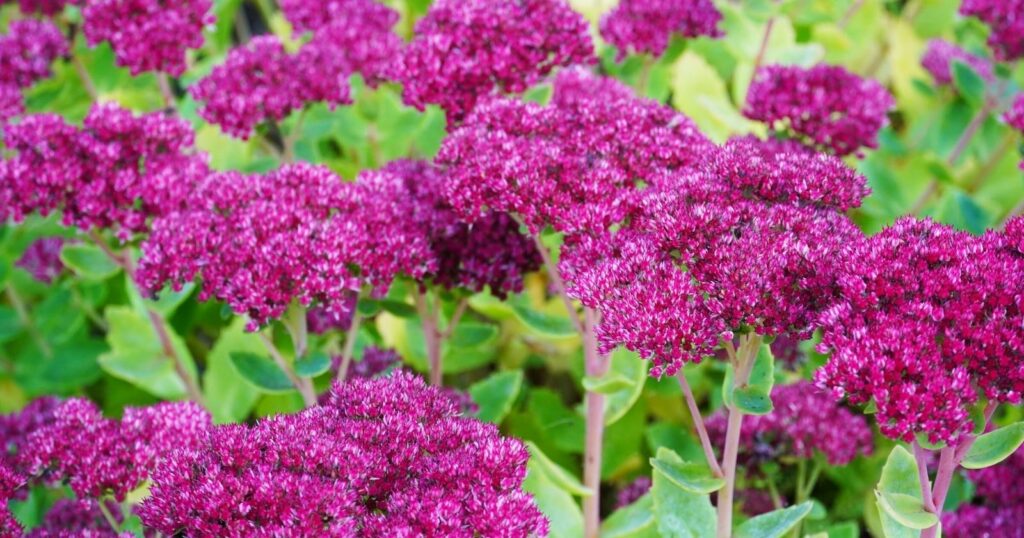
Scientific Name: Sedum
- Bloom Time: Summer – Fall
- Plant Type: Perennial
- Sun Exposure: Full sun
- Soil pH: Alkaline, Neutral
- Plant Zone: 3 – 9
Stonecrop is prized for its long bloom time and extended interest long into the winter months. There are hundreds of Sedum types offering a wide selection of sizes and colors, with the tallest growing up to 2 feet. The clustered blooms resemble broccoli, and the hundreds of small flowers are either red, pink, or white.
Sedums are classified as succulents, meaning they can tolerate drought. As it can handle most conditions, it is an ideal choice for poor soils and locations. It prefers well-drained soil and sunny spots. It’ll bring butterflies, bees, and hummingbirds to your yard too.
Tickseed
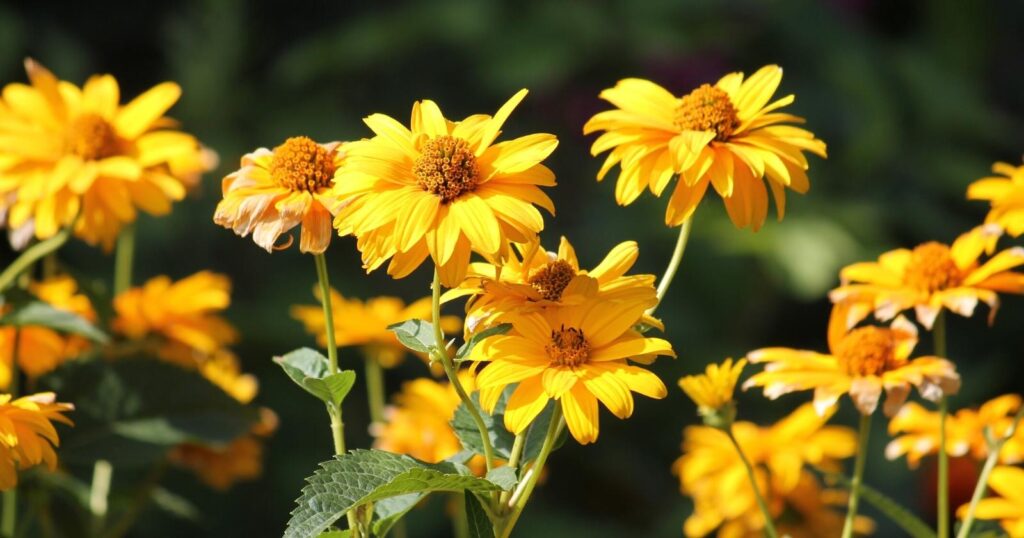
Scientific Name: Coreopsis grandiflora
- Bloom Time: Spring – Fall
- Plant Type: Perennial
- Sun Exposure: Full sun, partial sun
- Soil pH: Acid, Alkaline, Neutral
- Plant Zone: 4 – 9
There are many varieties of Coreopsis grandiflora which bloom early (spring and summer) or late (summer and fall). For an extended bloom season, pick at least 2 Coreopsis from each group. ‘Early Sunrise’ and ‘Presto’ are great companions for a longer blooming time. For the best visual impact, plant en masse.
Tickseed provides a warm array of hues, including yellow, orange, red, white, red, and pink. They generally grow up to 2 feet tall and are easy-to-place plants. They are low maintenance and require low levels of water to thrive.
Wallflower
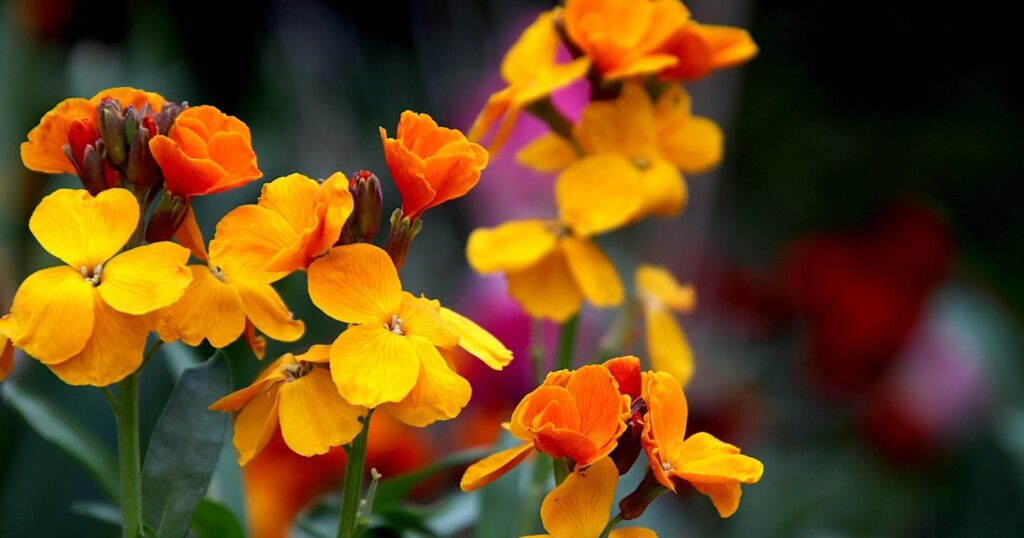
Scientific Name: Erysimum
- Bloom Time: Spring – Fall
- Plant Type: Biennial, Perennial
- Sun Exposure: Full sun
- Soil pH: Alkaline, Neutral
- Plant Zone: 6 – 9
Wallflowers are easy to grow and provide months of colorful flowers flowering from March to November in the right conditions. It is a perennial, although most grow it as an annual as it can become leggy. The delicate blooms sprinkled on tall stems are usually yellow, purple, and white in color.
The foliage is evergreen in warmer winter climates. It grows up to 16 inches tall and looks best at the front of borders. Wallflowers provide a reliable source of nectar to pollinators, making them a top choice for wildlife gardens.
Western Vervain
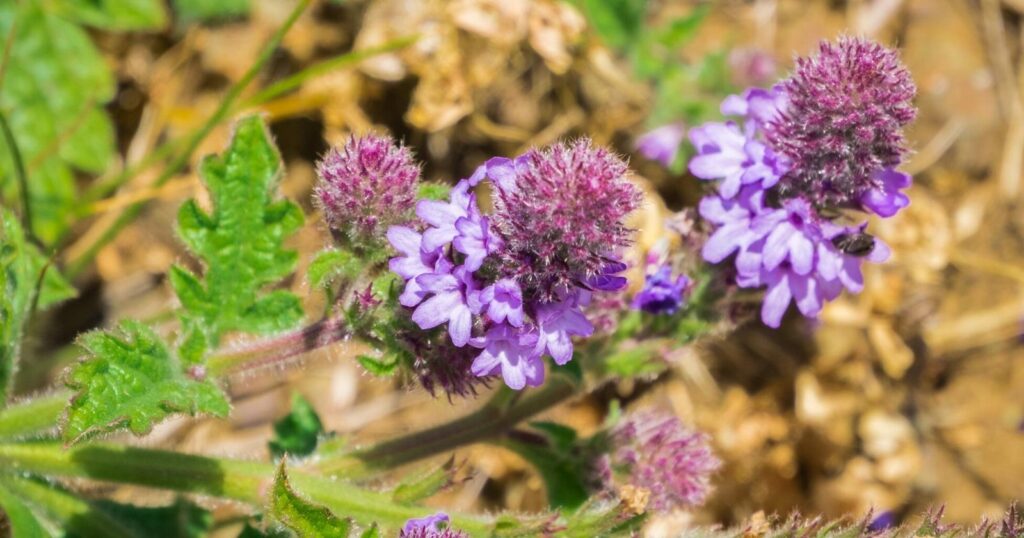
Scientific Name: Verbena lasiostachys
- Bloom Time: Spring – Fall
- Plant Type: Perennial
- Sun Exposure: Full sun
- Soil pH: Acid, Alkaline, Neutral
- Plant Zone: 4 – 10
This is a sprawling perennial that is prized for its long blooming season. The plant produces blue to purple flower spikes that sit on top of 3-foot-tall stems. The blooms open from the bottom up, providing a long summer show.
Western Vervain is native to western North America. In moist and good conditions it can be a vigorous spreader, so be sure to keep it in check. It can tolerate many conditions but likes moist, well-drained soils the most. It also attracts birds, butterflies, and bees.
Yarrow
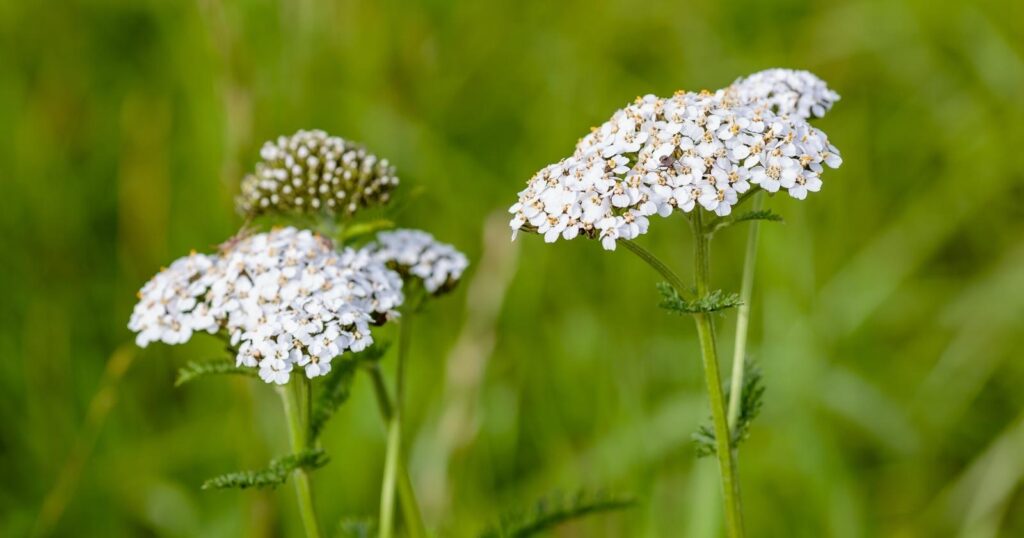
Scientific Name: Achillea millefolium
- Bloom Time: Summer – Fall
- Plant Type: Perennial
- Sun Exposure: Full sun
- Soil pH: Acid, Alkaline, Neutral
- Plant Zone: 4 – 9
Yarrow is prized for its long blooming time from summer to fall, still going when many other plants have faded. They can grow up to 3 feet tall, and the long stems carry a cluster of flowers that are usually pink, red, cream, white, and yellow in color. They look great in borders and containers and are fragrant too.
Achillea is relatively free from pests and disease. They require low to average water and need well-drained soils to thrive. They are also prized as cut flowers, in both bouquets and dried arrangements.
Zinnia
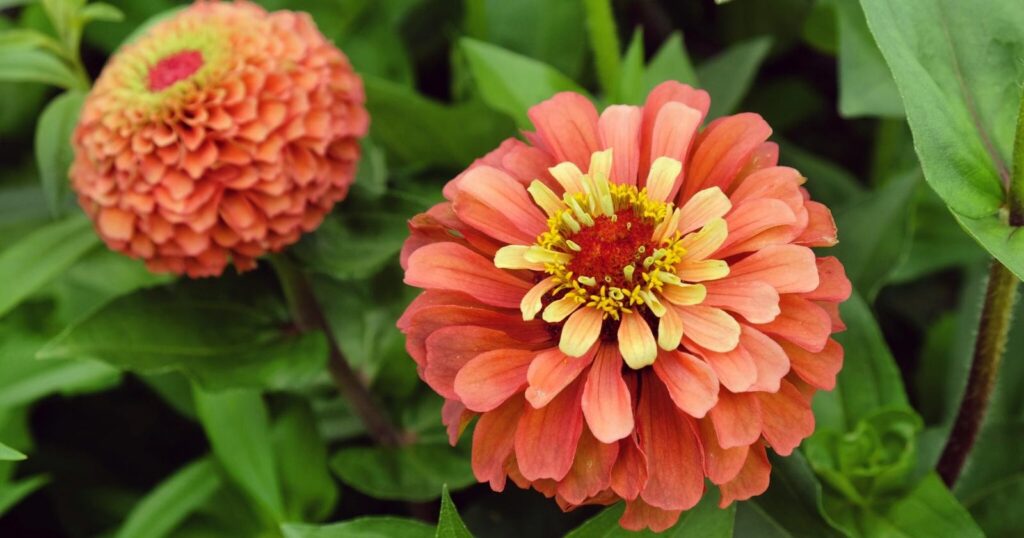
Scientific Name: Zinnia elegans
- Bloom Time: Summer – Fall
- Plant Type: Annual
- Sun Exposure: Full sun
- Soil pH: Acid, Alkaline, Neutral
- Plant Zone: 2 – 11
Zinnias are often described as one of the most rewarding summer plants thanks to their dramatic shape ranges, punchy color choices, and heights. Meaning that there is a Zinnia for every gardener and their needs. They come in all possible colors.
Zinnias are relatively easy to care for and they love full sun. They like evenly moist, well-drained, humusy soil to produce the best blooms. They typically grow between 1 and 3 feet tall. Don’t be tempted to plant as many as possible, as these flowers need air circulation to keep them disease free.
Wrap Up
You may have thought that designing your garden to achieve long-lasting blooms seemed like a difficult task. But hopefully, after reading this article we have made your choice a little easier. From spring through to fall, and sometimes winter, there is a flower for every moment of the year. And with the choices above, you can achieve bright colors all year round.

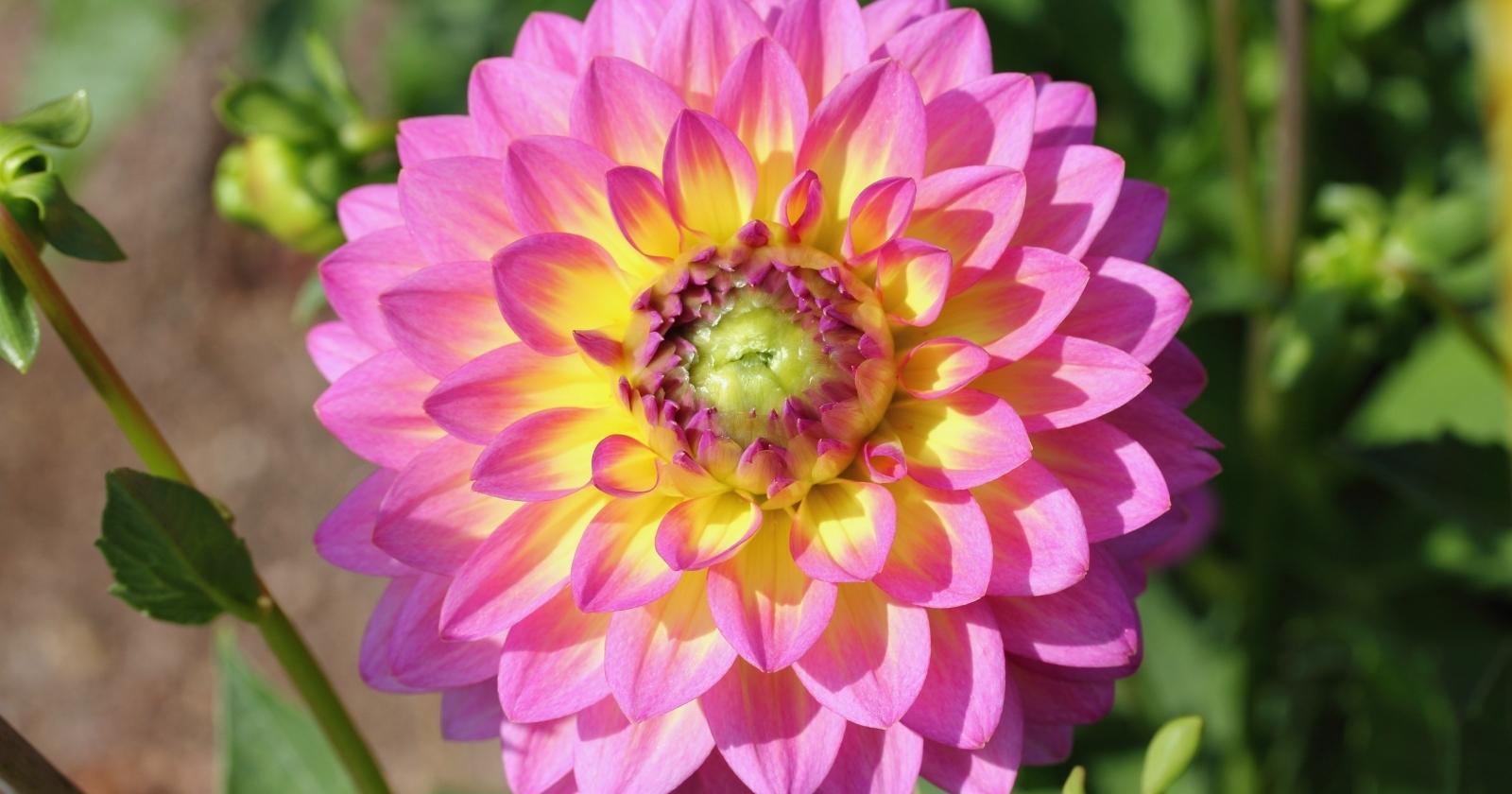
Leave a comment